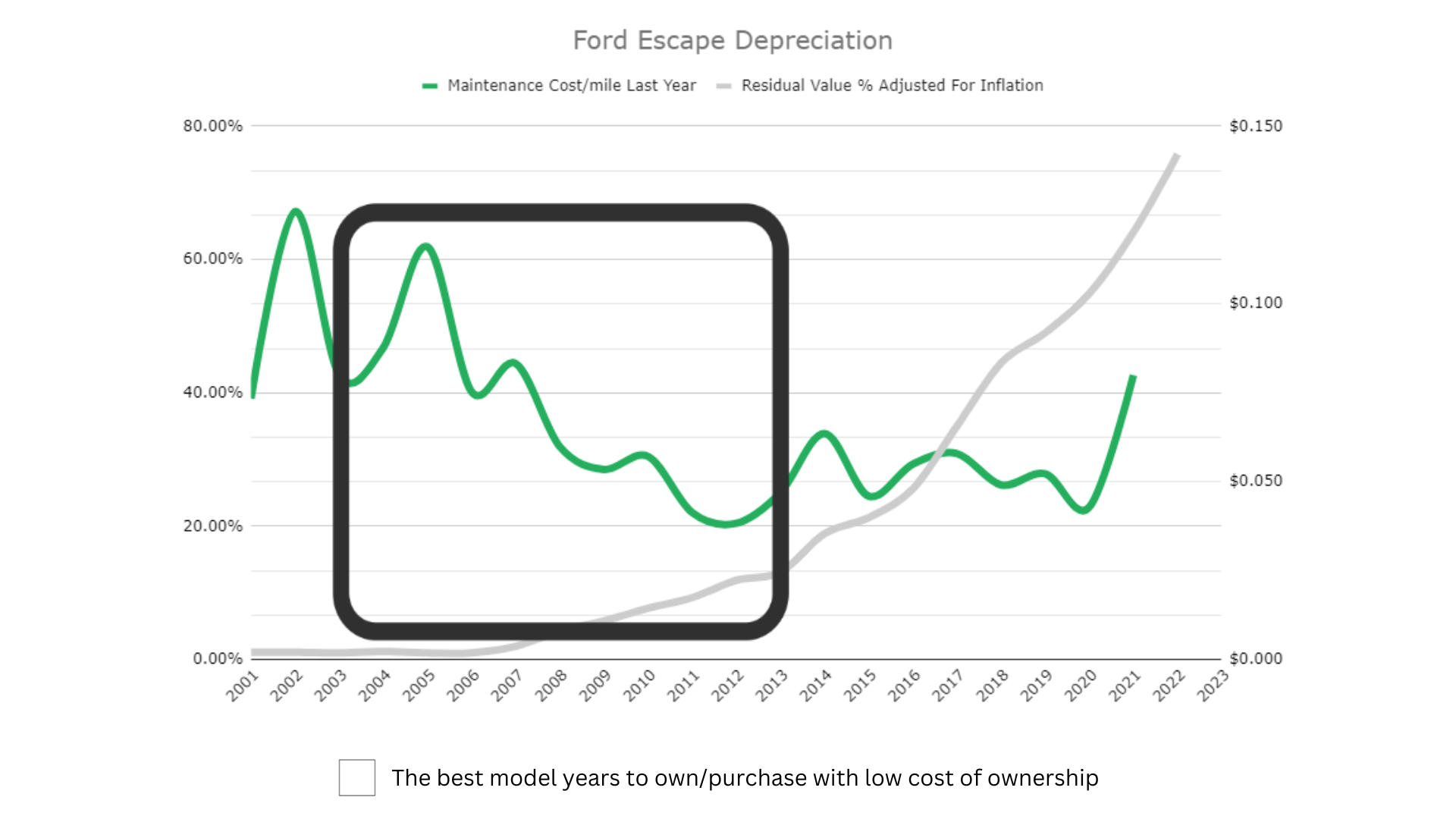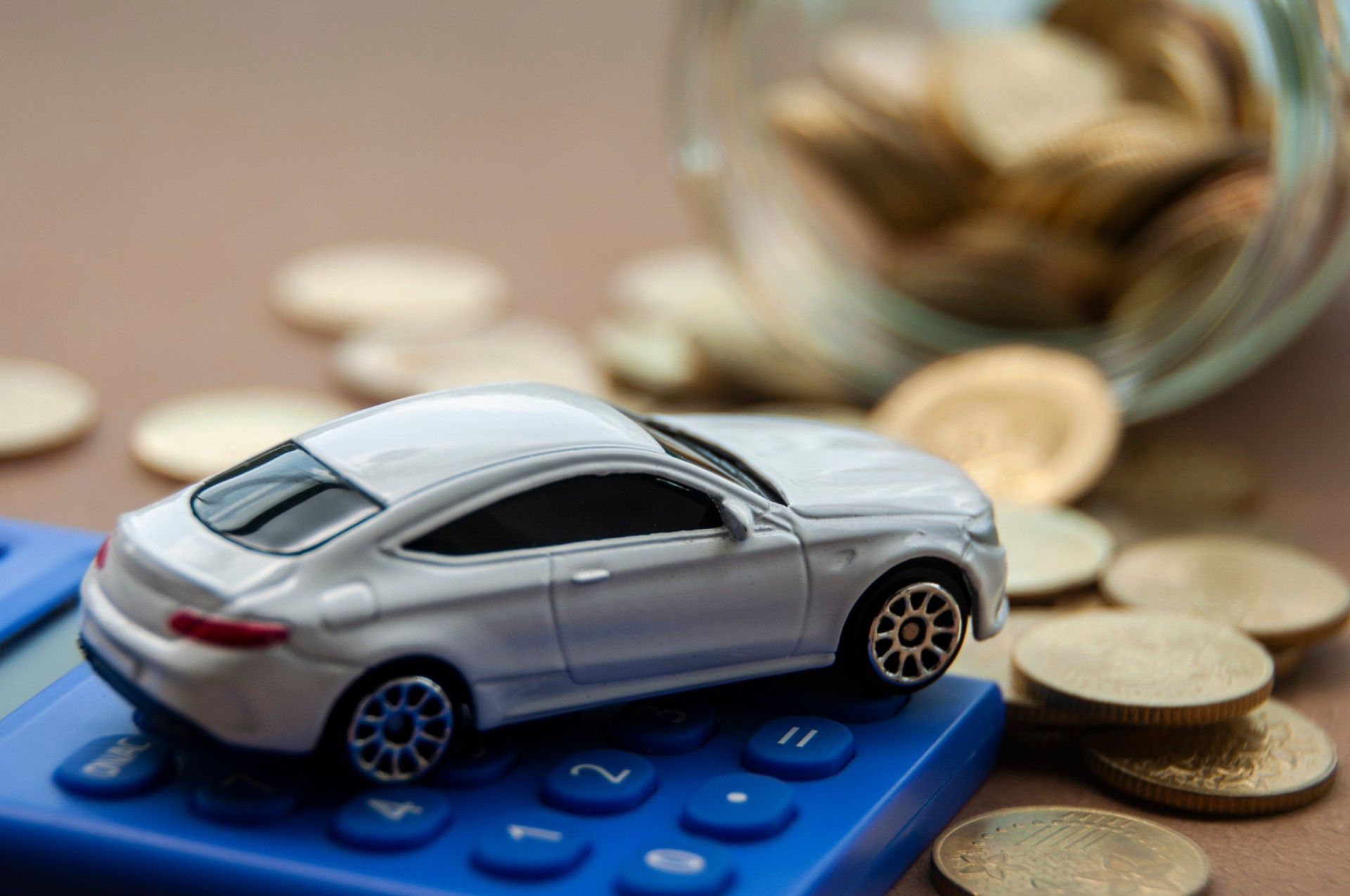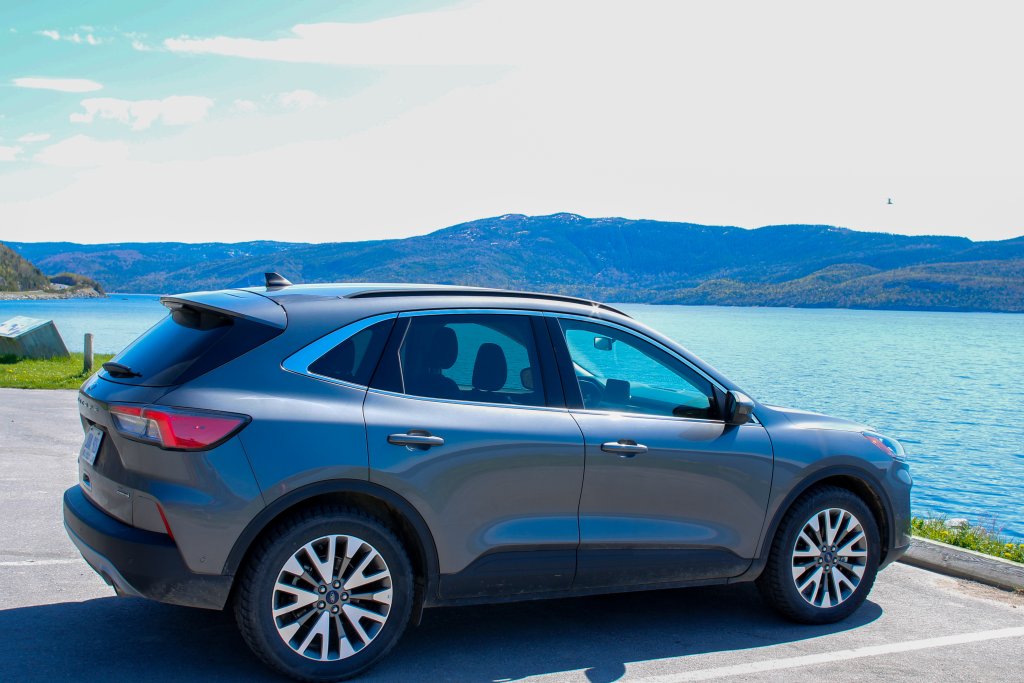Find the depreciation rate of your Ford Escape in the graph below.

When you purchase a new vehicle, it begins depreciating, or losing its value, as soon as you drive it off the lot. The same is true for the Ford Escape, as the highest amount of depreciation typically happens during the first year after you buy it. After the first 12 months, the Escape will depreciate more slowly each year until it reaches the eighth year of ownership.
For example, the depreciation rate for a new 2023 Escape jumps from 24.2% to 35.9% in the first two years of ownership. Between the eighth and ninth year of ownership, the depreciation rate only rises from 78.7% to 81.1%. Since various makes and models will have different depreciation rates, knowing the depreciation rate of your specific vehicle can help you prepare for its long-term value and the total costs you may encounter.
Keep in mind that just because the vehicle costs the least to own in the sweet spot we have outlined here, you still may not want to own the vehicle during these depreciation sweet spot years. Although vehicles depreciate less as they get older, they have more repairs. Duh right? However, keep in mind that repairs don’t just cost you money, they cost you time. Reliability is the difference between being able to make it to your destination on time or missing an opportunity because the car broke down.
Check out our article on the best and worst years of the Ford Escape to see our reliability ratings for all years of the Escape between 2001-2021. We also cover MPG, safety ratings, and a number of other factors. We pulled data from Escapes registered in our app and surveyed owners to get you data-backed answers on just how good or bad each year of the Escape is.
If you want to know the depreciation and maintenance costs for your particular vehicle, use our free “Total Cost of Ownership” tool available in the FIXD App – Android or IOS.
If you like our online tools and articles consider purchasing our FIXD sensor for $19.99 (this is 67% OFF). It’s our flagship product. With it, you scan your car for common engine problems.
If our sensor detects any problems with the engine, our app will clearly explain:
- What could have caused it and
- How much the possible repairs may cost.
If you’d like, we’ll even show you trusted repair shops in your area where you can get your ride fixed through RepairPal. The total cost of ownership feature within the app totals your maintenance costs, repairs, and depreciation (Sensor + App). This is free on the app.
Ford Escape Depreciation
| Model Years | Mileage | Amount Depreciated | Residual Value Percentage | Resale Value |
| 2001 | 264,000 | $ 21,861.67 | 1.1% | $250 |
| 2002 | 252,000 | $ 23,174.11 | 1.1% | $250 |
| 2003 | 240,000 | $ 24,036.81 | 1.0% | $250 |
| 2004 | 228,000 | $ 24,022.16 | 1.2% | $288 |
| 2005 | 216,000 | $ 24,626.99 | 1.0% | $250 |
| 2006 | 204,000 | $ 25,727.72 | 1.0% | $250 |
| 2007 | 192,000 | $ 25,769.43 | 2.0% | $527 |
| 2008 | 180,000 | $ 23,595.60 | 4.3% | $1,061 |
| 2009 | 168,000 | $ 26,767.19 | 5.8% | $1,654 |
| 2010 | 156,000 | $ 24,426.47 | 7.7% | $2,046 |
| 2011 | 144,000 | $ 24,185.90 | 9.3% | $2,473 |
| 2012 | 132,000 | $ 23,313.73 | 11.9% | $3,158 |
| 2013 | 120,000 | $ 24,739.03 | 13.1% | $3,717 |
| 2014 | 108,000 | $ 22,399.03 | 18.9% | $5,237 |
| 2015 | 96,000 | $ 22,015.60 | 21.3% | $5,943 |
| 2016 | 84,000 | $ 21,197.55 | 25.6% | $7,311 |
| 2017 | 72,000 | $ 18,583.50 | 35.0% | $10,008 |
| 2018 | 60,000 | $ 16,107.74 | 44.5% | $12,926 |
| 2019 | 48,000 | $ 14,923.79 | 49.0% | $14,311 |
| 2020 | 36,000 | $ 14,220.21 | 54.9% | $17,306 |
| 2021 | 24,000 | $ 10,636.62 | 64.1% | $18,998 |
| 2022 | 12,000 | $ 6,740.87 | 75.8% | $21,136 |
| 2023 | 0 | N/A | N/A | N/A |
| 2024 | 0 | N/A | N/A | N/A |
The chart above conveys the approximate depreciation for a Ford Escape. It is based on Kelley Blue Book data since 2001, assuming a vehicle in standard trim, a generic color such as black or white, and a mileage of 12,000 per year.
Keep in mind that the auto market was heavily affected in 2020 and beyond. Automakers selling new cars during the COVID pandemic raised prices which caused a spike in demand in the used car market as people tried to save money. Many automakers, however, did not drop prices after the pandemic, they kept them so they could make a larger profit.
This is why the most recent years of many vehicles have seemingly experienced less depreciation. Some, such as 2019 or 2022 may have even appreciated due to the heightened levels of inflation created.
Factors That Impact the Ford Escape Depreciation Rate

Ford is known for producing high-quality vehicles that are resilient, and the Escape is no different. It typically holds its value well and may depreciate more slowly than similar vehicles due to its high reliability ratings and lower-than-average maintenance costs. However, many factors can affect a vehicle’s depreciation, so paying attention to these when purchasing is key. Here’s a bit more information about the factors that can impact the depreciation rate of the Ford Escape.
Age
A car’s age refers to how many years have passed since it was initially sold. This differs from a car’s model year, which is often the year after its official release. This means you may buy a new Ford Escape in 2022 that’s listed as a 2023 model. The older a car gets, the more it can lose value, as it’ll depreciate a bit every year after its original purchase.
The one exception is classic cars, as they are typically collector’s items that hold their value well due to their rarity.
Body Type
A car’s body type describes the configuration and design of the vehicle, often corresponding to its size and function. Common body types include sedans, pickup trucks, SUVs, and hatchbacks. A car’s body type can affect its depreciation rate because some types hold their condition and value more effectively than others, especially depending on the climate where they’re kept. For example, a small sedan in an area that experiences heavy amounts of snow may depreciate more quickly than a rugged pickup truck in the same climate, as the pickup may suffer less wear and damage.
The Ford Escape is an SUV that typically holds its value well since it can maintain its condition effectively when taken care of. However, an SUV can sometimes lose value more quickly than other models since it can have a higher starting MSRP than smaller cars.
Mileage
Mileage refers to the number of miles a car has driven, as shown on the odometer. A car with exceptionally high mileage will likely have a lower resale value than a car of the same age, make, and model with less mileage on the odometer. This is because high mileage indicates that a car has been driven for longer, giving it a higher chance of having a history of accidents and costly repairs.
It’s often recommended to stick with vehicles that have around 12,000 miles or less per year on the odometer, which usually indicates mild, regular use. When a car has more mileage than this, the chances are higher that it will depreciate more quickly after you buy it due to needing repairs or replacement parts. We base our model on 12,000 miles of driving per year.
Overall Condition
A vehicle’s overall condition can also affect its resale value, as a car that’s undergone several repairs may have the potential to break down again later, needing more mechanical work. If a car has noticeable wear, such as dents in the doors or cracked headlights, it can also be a sign of rapid depreciation later since these issues can lead to the need for more repairs in the future.
To ensure a used vehicle might maintain its value well, thoroughly inspect the vehicle you’re considering to assess its condition. Look at the exterior and the interior to identify broken parts or malfunctioning features.
Color
Even a car’s color can affect its depreciation rate. According to a recent study, the color that seems to hold its value most effectively is yellow. This is mainly because yellow cars can remain in high demand, even years after their initial release, since it’s not as popular a color to choose. According to this study, beige, orange, and green are other colors that can hold their value well.
To escape the highest depreciation levels, you can avoid buying a car in gold, brown, black, and silver colors. Since these are often popular color choices among customers, there are usually more on the used vehicle market. This makes it easier to find them when shopping for a used car but also causes them to depreciate more quickly.
Other Costs of Ford Escape Ownership
A vehicle’s depreciation rate is only one aspect of the total cost of owning a car. Here are a few other costs of ownership you can encounter with a Ford Escape.
Insurance
Insurance is essential for every driver, as it can protect you from incurring high costs when you get in an accident. The rate you’ll pay can vary, depending on factors such as the age, make, and model of your vehicle and your driving record. Trim levels with advanced safety features, such as newer versions of the Escape, can often have lower insurance costs since they can pose a lower risk to providers.
The Ford Escape is often considered one of the cheapest cars to insure. According to CarEdge, the average cost of insurance for a Ford Escape is around $1,484 per year. This is lower than the average cost of insuring an SUV, which hovers around $2,225 annually. In Kentucky, the 2021 Escape is identified as one of the cheapest cars to insure, with an average cost of $111 per month for full coverage insurance and $42 per month for liability-only coverage.
Maintenance
It’s essential to maintain any vehicle regularly, as they all need some type of maintenance to continue running effectively. When you bring a Ford Escape in for regular oil changes and inspections, you can ensure it remains in the best possible condition, which will help maintain its value. The average cost for maintaining a Ford Escape is around $651 per year, but you can also research other factors that affect maintenance costs to plan your budget accordingly. To determine your exact potential maintenance costs, you can compare the costs of maintenance by model year for the Escape using our graph.
The Best Model Year To Buy a Ford Escape
Based on factors including price and reliability (but not depreciation), our choice for the best Ford Escape model years to buy are the 2003, 2013, 2014, 2015, 2017, 2018, 2019, 2020, and 2021, but check out our article on the best and worst years of the Ford Escape to get the whole story.
Buying a Ford Escape New vs. Used
| 20-Year Projection | ||
| Years Since Purchased | Depreciated Value | With Inflation |
| 1 | $21,224 | $23,430 |
| 2 | $17,948 | $20,973 |
| 3 | $15,372 | $18,057 |
| 4 | $13,720 | $16,177 |
| 5 | $12,460 | $14,621 |
| 6 | $9,800 | $11,471 |
| 7 | $7,168 | $8,403 |
| 8 | $5,964 | $7,032 |
| 9 | $5,292 | $6,261 |
| 10 | $3,668 | $4,386 |
| 11 | $3,332 | $4,051 |
| 12 | $2,604 | $3,254 |
| 13 | $2,156 | $2,742 |
| 14 | $1,624 | $2,087 |
| 15 | $1,204 | $1,524 |
| 16 | $560 | $702 |
| 17 | $280 | $350 |
| 18 | $280 | $352 |
| 19 | $336 | $420 |
| 20 | $280 | $345 |
While a new Ford Escape typically holds its value well, you can save yourself more money in the long run by purchasing a used model from a year with slower depreciation. For example, a new Ford Escape has a starting MSRP of $28,000.00. After 3 years of ownership, the car would be worth about $15,372. A used two-year-old Ford Escape is worth $18,998 in 2023.
When buying a used model, you can find the years with the lowest depreciation costs by researching the best and worst years for the vehicle online. You can also avoid purchasing a model with rapid depreciation by paying attention to the condition and design of the car you’re looking at. For instance, a car with noticeable damage and customizations on the exterior may hold its value less effectively than a model from the same year with standard features and no obvious damage. To ensure you get the best deal, you can reference our used car buying checklist.
Methodology
The data in this article applies to the base model trim for the Ford Escape with standard equipment and design options. When a vehicle has multiple trim levels, each trim can have a unique value, and certain trim levels may hold their value better than others. The COVID-era chip shortage can also affect resale value. Other factors that can impact resale value include the overall condition of your vehicle and the way you decide to sell it, such as to a private party or through a dealership.
Keep in mind, there are large economic factors at play here too and the sale of new cars has caused shifts in the used market too. There is a stark difference in the cost of vehicles due to car manufacturers seeking higher profit margins after COVID as detailed by CNN and posted by CBS channel 58:
“… (T)he auto industry saw sky-high profits even as sales plummeted. Domestic manufacturers of cars and car parts saw a profit of $32 billion through the third quarter of 2022 (the latest data available) — their largest profit since 2016. Car dealerships also reported record-breaking profits through Q3, according to auto-retail advisers Haig Partners.
That’s because pandemic-era pent-up consumer demand remained strong as supply shifted, allowing automakers to increase their prices and their profit margins. Cars and trucks were sold nearly as soon as they hit dealership lots, and the average price paid for a vehicle in December soared to a near-record high of $46,382, according to J.D. Power.
Data from the Labor Department’s November Consumer Price Index shows American consumers are paying about 20% more for cars than they were in 2019.
The trend could continue into next year — research website Edmunds expects new-car sales to hit 14.8 million in 2023, a marginal increase from last year but well below pre-pandemic levels.
The auto industry has entered a new era: Less choice, higher prices and larger profit margins. So far it seems to be working for them.”
This shift by car companies to create higher profit margins by taking advantage of the heavily-reported-on chip shortage panic of COVID has had rebounding effects upon the value of used cars.
Be aware that newer years (the latest 3-4 model years) may be inflated in price because of this and depending on how big this problem is for the model you are considering – it may even be inflating the price of the older model years.
Frequently Asked Questions About Vehicle Depreciation
Do Ford Escapes hold their value?
A Ford Escape will typically hold its value reasonably well, especially when it’s in great condition. However, the exact value that an Escape maintains can vary due to several factors, including previously mentioned ones such as age, color, and mileage. The value you get for a used Escape can also differ when you trade it in at a dealership versus selling it to a private party.
For example, according to Kelley Blue Book data, the average trade-in range for a base-trim 2021 Ford Escape with standard features is between $18,524 and $20,075 when you sell it to a dealership as part of a trade-in. For the same vehicle, KBB shows that you can get between $20,617 and $22,376 when you opt to sell to a private party.
What are the best years of the Ford Escape to buy and which ones should you avoid?
The best years to buy a used Ford Escape are the 2003, 2013, 2014, 2015, 2017, 2018, 2019, 2020, and 2021 model years. This is largely due to the outstanding reliability ratings and safety scores of vehicles from these years, along with lower maintenance costs. In terms of the worst years, you should avoid purchasing a used Escape from 2001, 2002, 2004, 2005, 2006, 2007, 2008, 2009, 2010, 2011, 2012, and 2016. Escapes from these years show lower reliability scores and high chances of mechanical failures, which can lead to costly repairs.
What's high mileage for a Ford Escape?
A Ford Escape is typically considered to have high mileage when it reaches 115,000 miles on the odometer. However, some Escapes have the potential to remain functional beyond this mileage as long as they receive routine maintenance and extra care.
How old of a Ford Escape should you buy to avoid most of the depreciation?
The sweet spot for buying a used Ford Escape falls between the 2003-2013 model years. To give yourself the chance of accumulating the least depreciation, you should buy a used vehicle from 2008, as this will keep your purchase within at least five years of the sweet spot for depreciation.
References
(2023.) How To Beat Car Depreciation. Kelley Blue Book. Retrieved September 19, 2023, from https://www.kbb.com/car-advice/how-to-beat-car-depreciation/
(2023.) Ford Escape Depreciation. CarEdge. Retrieved September 19, 2023, from https://caredge.com/ford/escape/depreciation
(2023.) What Is Car Depreciation? Progressive. Retrieved September 19, 2023, from https://www.progressive.com/answers/what-is-car-depreciation/
(2023.) 12 Factors That Affect Your Car’s Resale Value. Money Crashers. Retrieved September 19, 2023, from https://www.moneycrashers.com/factors-affect-used-cars-resale-value/
(2023.) The Best and Worst Car Colors for Resale Value. iSeeCars. Retrieved September 19, 2023, from https://www.iseecars.com/car-color-study
(2023.) Ford Escape Insurance Cost. CarEdge. Retrieved September 19, 2023, from https://caredge.com/ford/escape/insurance

At FIXD, our mission is to make car ownership as simple, easy, and affordable as possible. Our research team utilizes the latest automotive data and insights to create tools and resources that help drivers get peace of mind and save money over the life of their car.














